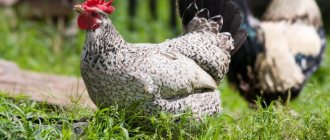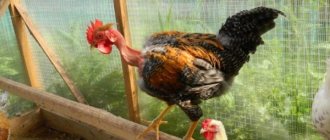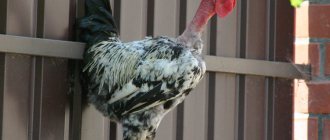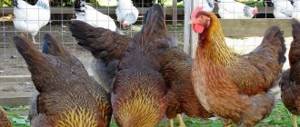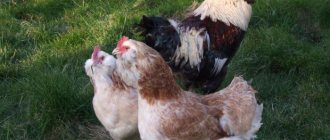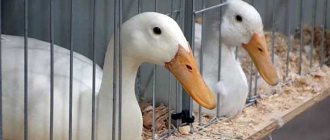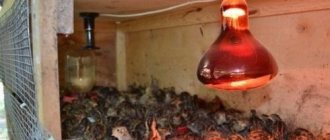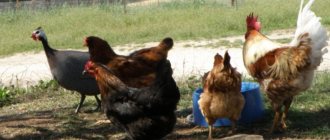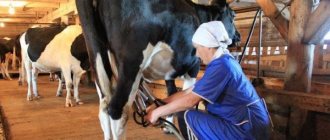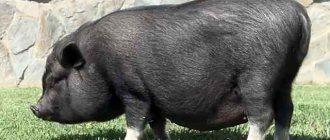Origin and history of breeding
The origin of the breed is unknown, as it has been living in Indonesia for several centuries. There is a hypothesis that the parent breed was the Ayam Begisar, which has the color of the Bank jungle fowl. A distinctive feature of ayam tsemani is a gene mutation that leads to the disease fibromelanosis. In fibromelanosis, melanin activity is increased 10 times. The consequence of the disease was the black coloration of the ayam tsemani.
Literally translated from Javanese, ayam tsemani means “black hen”, ayam means “chicken”. All Javan chicken breeds bear this prefix.
Black Ayam Tsemani breed of chickens
Origin story.
The unique chicken, according to scientists, has existed for several millennia. But, due to the fact that the breed is very ancient, only a few data about it have been preserved in history. A large number of them still have no confirmation.
Here are some facts.
- The name of the exotic variety in translation sounds like this: “Tsemani chicken.”
- The homeland of the feathered beauty is the outskirts of the town of Solo, which is located in Middle Java in Indonesia.
- The ancestors of unusual quons are considered to be aboriginal chickens that previously lived on the islands of Indonesia.
- Scientists have put forward a hypothesis that there is no pure breed in the world, there is only a very similar hybrid, which is called by its name today.
- Despite its centuries-old “age,” it became widespread only in the 20th century, when Dutch colonialists began to explore it in 1920. But it came to Europe and other countries of the world only at the end of the 20th century.
- To this day, work is being carried out aimed at its study and preservation.
- The hen is classified as an exotic, decorative type.
These chickens are similar to the Lakendazi or Ukheyiliyu breed of chickens.
Description and appearance
The mutation did not affect the reproductive organs and blood. The remaining organs, including internal ones, are black in the tsemani. The mutation is dominant and also appears in crossbreeds.
Rooster Ayam Tsemani
Medium sized breed. Roosters weigh 2-3 kg, chickens 1.5-2 kg. The body is slender. The crest is large, leaf-shaped, the eyes are black. Any “lightening” in color indicates that the bird is not purebred.
In Russia, adult birds weighing up to 1.5 kg are offered for sale. Shredding is a characteristic sign of inbreeding.
Advantages and disadvantages of the breed
It is quite simple to describe the key advantages of the breed, since they include all the advantages most valued by every poultry farmer:
- Quite a lot of tender exotic delicacy meat. The live weight of adult cockerels reaches 2 kilograms, chickens - 1.5 kg.
- High survival rate of offspring without particularly complex care of young animals.
- Well-developed maternal instinct in hens.
- Using an incubator does not affect survivability.
- Excellent immunity that protects birds from many diseases from the first moments of life.
- An interesting unusual appearance of purebred individuals, which made them a desirable decoration of the yard for any poultry farmer in Europe.
Ayamok has only two significant disadvantages. The main disadvantage of these birds is the high cost of individuals. Young animals, even in their historical homeland of Indonesia, are difficult to purchase for less than $200. European poultry farmers even ask for a chicken or cockerel from 1000 to 3000 thousand USD.
The second disadvantage of the bird is increased sensitivity to cold. Maintaining it in cold latitudes without building an expensive heated poultry house is simply impossible. For the same reason (and also because of the first drawback), Tsemani have not yet become widespread in private poultry farming. But this is only for now - many exotic breeds, now ubiquitous, were previously considered exclusively the poultry of aristocrats.
Main characteristics of ayam tsemani
Apart from the color of the meat and body organs, Ayam Cemani is no different from other Javan chickens. Being a breed developed spontaneously and not in laboratory conditions, the Cemani is a late maturing breed. The fertility of eggs is low, which is associated either with inbreeding or with a genetic disease inherent in the breed.
According to unconfirmed reports, due to long growth, the meat of black chickens accumulates more nutrients than the products of broiler breeds.
Chicken Ayam Tsemani
Productivity and egg production
The breed is classified as decorative even in its homeland. Meat productivity is average: chicken weighs 1.5-2 kg, rooster - 2-3 kg. Egg production in the first year is 60-100 eggs. In subsequent years, egg production decreases. The weight of the egg does not exceed 50 g. The shell of the eggs is light cream.
Rate of maturation and ability to lay eggs
The ability to lay eggs in pullets appears at 9-12 months, depending on the quality of feeding. Roosters mature at the same age. The late ripening of cockerels allows owners to keep them together for up to 6 months, and then fights begin.
Egg Ayam Cemani
Hatching instinct
Tsemani laying hens have no incubation instinct. To breed this breed you will need an incubator. The hatching egg can be stored for no more than 10 days. Since laying hens do not perceive eggs as their offspring, they can peck them. Collect eggs for incubation 2 times a day.
Be sure to read:
Breeds of white laying hens and meat birds with photographs, names and descriptions
Productivity
Weight
Representatives of the Ayam Tsemani breed cannot “boast” of leading positions in egg and meat indicators. However, the products they produce are tasty and healthy.
The ayam tsemani rooster, although tall, is not heavy. Maximum live weight – 2.5 kg. The chicken weighs 0.5-1 kg less.
Meat
Ayam Tsemani develop more slowly than others. Therefore, their meat has a high concentration of chemical components and beneficial substances, giving it a rich taste and aroma.
It is non-greasy and rich in protein. Used to prepare a variety of dishes: appetizers, main dishes, soups and even desserts. For example, the famous Turkish dessert Tavuk (“Chicken Breast”).
In addition, tsemani chicken meat is used in folk medicine to treat infertility and some diseases of the respiratory, digestive and cardiovascular systems.
Chickens must be slaughtered when they reach three years of age. Afterwards the taste of the product deteriorates. However, due to the high price, this is rarely done, using aged or culled birds to obtain meat.
Eggs
Egg production in ayam tsemani chickens is low and late. They begin to lay eggs at the age of 7-8 months. At first they bring 60-100 eggs, then about 120.
The first year the eggs are usually small - weighing 30-35 g. Afterwards they are larger - about 50-55 g.
The shape of the eggs is correct. Shell color is white or beige. The yolk-to-white ratio, as well as the taste and smell, are no different from the characteristics of eggs from other chicken breeds.
A decrease in egg production in ayam tsemani chickens occurs during seasonal molting and the onset of cold weather.
To improve performance during molting, you should not take any measures - all the reserves of the chickens’ body are aimed at changing feathers.
In winter, it is enough to improve the living conditions of chickens, providing them with adequate nutrition and high-quality heating.
When egg production stops completely, the flock is replaced.
Practical recommendations for keeping ayam tsemani
Tsemani have no fundamental differences from other capricious breeds of chickens (faverolles). Compliance with the conditions common to all chickens when keeping and breeding the breed will allow you to successfully obtain offspring.
How to build a chicken coop yourself
It is not necessary to build a special room for a chicken coop. A barn or poultry house where other pheasants lived would be suitable. When building from scratch, a standard barn is made of timber or stone: 4 walls and a roof. There are no specific requirements for walls. The height of the poultry house is 2.5 m.
The roof must be able to withstand the weight of snow in cold regions and protect from heat in the southern part of the country. In the north, transparent polycarbonate is suitable for the roof.
A separate section is made for each ayam tsemani family. The same thing applies if you plan to keep several breeds of poultry in the chicken coop. The poultry house is divided into sections using chain-link mesh to ensure normal air circulation in the room.
Ayam Tsemani
Choosing a chicken coop location
The chicken coop is placed in a dry place that is not flooded by groundwater and flood waters. If there is no such place on the site, the soil is pre-drained and a foundation is installed under the poultry house.
Ayam Tsemani is a heat-loving breed of chicken and does not survive in a cold room in winter. In northern latitudes, housing for tsemani is made in a sunny place. In the south, the chicken coop is placed so that in the summer it is in the shade.
Summer paddock
The enclosure for tsemanis is made with a closed top, since tsemanis fly well. The soil is not necessarily grassy; chickens will quickly destroy all the grass and will walk on bare ground. It is more effective to use fine gravel and add greens to the diet. Fence the enclosure with a large chain-link mesh. Wall height 2 m.
Ayam Tsemani
The enclosure is equipped with drinking bowls, feeders and ash baths. Be sure to place containers with coarse sand next to the feeders.
Young birds are not placed with adult birds.
Setting up a chicken coop
In the poultry house for tsemani, perches are installed at a height of 1.2-2 m. The arrangement of perches with a “ladder” allows you to place a larger number of birds in the same area.
For the winter, the chicken coop is equipped with drinkers, feeders and ash baths. Heating is provided as needed. The floor is lined with sawdust or straw. Straw is suitable for tsemani.
Bright light
For lighting 20 sq. m of poultry house, one 40-watt light bulb is enough. The equivalent of 40 watts for energy-saving lamps is indicated on the packaging. Otherwise, bright light provokes aggression. To extend the egg-laying season in winter, the chicken coop is illuminated for 12-14 hours.
Chicken Ayam Tsemani
Ventilation
For natural ventilation in the southern regions, double doors are made in the poultry house: from metal mesh and solid. The latter will be needed in winter. A small gap is left between the roof and the wall.
In the northern regions, they use forced ventilation so that in cold weather it can be turned off.
Comfortable nests and perches
For nesting boxes, boxes are made that cover the hen on three sides. For tsemani, sizes 30x50x20 cm are suitable. Straw or hay is placed at the bottom of the box. Sawdust cannot be laid down, as it “spreads” to the sides, and the chicken will damage the egg lying on the bare boards.
Be sure to read:
Cochins: pros and cons of the chicken breed, breeding and maintenance features
The perches are made from timber with a diameter of 5 cm. The edges of the timber are rounded so that the birds do not injure their paws. The bars are taken dried and without cracks, so that they do not harbor bird parasites. Aspen or oak are better suited for perching.
Feeders and drinkers
Feeders should not allow chickens to scatter food. The feeder is installed with a groove or hopper. The feeding holes in it are made so that the chicken does not climb into it with its legs.
The best option for a drinking bowl is a nipple one. The water in nipple drinkers is always fresh. Since the water container is closed, birds cannot throw debris into it.
The best option for a drinker is nipple
The second most convenient drinking bowl is a vacuum one. Dirt gets clogged into the tray of the drinking bowl placed on the floor, and the chickens spill water from the suspended drinking bowl. In winter, spilled water freezes, creating inconvenience for chickens and leading to colds.
What can you do to prevent chickens and roosters of the Ayam Tsemani breed from fighting?
To prevent fights between pheasants, there are two devices:
- glasses;
- beak ring
Glasses prevent opponents from “aiming”, as they leave only peripheral vision for the birds. The ring does not allow you to close your beak and fully hit or peck your opponent. Disadvantages of devices: ayam tsemani glasses are removed; the ring damages the beak.
Content Features
Where to keep
Tsemani chickens are afraid of noise and love warmth. Otherwise, they are no different from other chickens.
A chicken coop for ayam tsemani is built in a quiet place, isolated from other buildings, protected by trees from sunlight in summer and drafts in winter.
On a hill, away from groundwater. Made from environmentally friendly materials. With windows facing south to provide the chickens with maximum natural light.
The type of keeping ayam tsemani chickens can be cage or floor. The main thing is that the birds have enough space. Recommended stocking density: 2 birds per 1 m².
Light and warmth
Bright light contributes to the comfortable well-being and productivity of ayam tsemani chickens.
In the summer, chickens have enough natural light. In cold weather, daylight hours are extended to 10-12 hours using electric lamps, systematically turning them on and off at the same time.
Ayam tsemani are thermophilic. Therefore, the temperature in the room where they live is maintained within 15-25 °C throughout the year.
The body of black chickens reacts to lower temperatures with an exorbitant appetite and an almost complete cessation of egg laying. At higher levels – increased aggressiveness, decreased egg weight and quality.
It is recommended to insulate the walls of the chicken coop with polystyrene foam, mineral wool or any other waterproofing materials. Better - from the outside of the facade. When installing insulation inside, the usable area of the room is “stolen”. In addition, curious chickens may begin to peck at the “pliable” material.
Microclimate
Any heat source can provide a comfortable microclimate for ayam tsemani chickens: a wood stove, an oil heater, an electric convector, an infrared lamp or a gas heating system.
The air humidity in the room should be between 60-75%. If it is higher, it may negatively affect the health of the birds. It is better to correct the situation by increasing the temperature and removing excess drinking bowls, from the surface of which water evaporates.
Tsemani chickens have a greater need for oxygen than other birds. Their oxidation processes are faster and more intense, and harmful gases are released when breathing.
Air purity in the poultry house is regulated by installing ventilation ducts. It doesn’t matter whether the ventilation is natural or artificial - the main thing is that it provides an air exchange of at least 7 m3/h per 1 kg of bird weight in the absence of dangerous drafts.
Interior arrangement
High-quality bedding serves as a source of additional heating for ayam tsemani chickens.
It is arranged in two layers: the first is slaked lime (in the proportion of 1 kg per 1 m2), which protects birds from ticks and fleas. The second is peat moss, sawdust or straw (5-8 cm high), which is periodically loosened with a pitchfork or replaced.
In winter, due to the natural composting process, this litter generates heat. And in the summer it can be used as fertilizer for the garden.
Any suitable sized boxes made of wood or plastic are used as feeders for Ayam Tsemani chickens. As drinking bowls - open containers or specialized drip systems.
Nests are arranged in order to accustom ayam tsemani chickens, deprived of maternal instinct, to lay eggs in one place, and not scatter them anywhere.
Perches are arranged for the birds to rest comfortably. In a cage or around the perimeter of the chicken coop, at a distance of at least 30 cm from each other.
Walking chickens
Summer walking yards for ayam tsemani chickens are installed close to the chicken coop so that the birds can go outside on their own. The walls of the pens are raised by 2-2.5 m, the roof is covered with netting, since the birds can fly high.
In the cold season, chickens are not allowed outside to avoid frostbite, compensating for the lack of walking with high-quality ventilation and bathing in boxes with sand.
Feeding the breed
Adult chickens are fed 2 times a day. Young animals are given free access to the feeder.
Feeding adults
Laying hens need grain feed with a high content of calcium and vitamin E. Calcium is found in legumes, vitamin E is added separately. The chicken diet includes:
- wheat;
- barley;
- oats;
- soy;
- peas;
- beans;
- feed chalk;
- feed sulfur;
- vitamin and mineral premixes;
- protein supplements.
Protein in the diet of laying hens is an essential component.
Protein in the diet of laying hens is an essential component. Otherwise, the chickens will peck the eggs. The grain is given crushed. In addition to grain, chickens are fed green grass and finely chopped vegetables.
Feeding the chickens
The chickens are fed starter feed. The standard recipe - boiled millet with egg is not suitable for tsemani. Wet food turns sour quickly. You can add a boiled egg to the starter feed. The quantity of eggs is calculated so that the chickens eat it in 5 minutes. The uneaten egg is removed. Compound feed is left freely available.
Description of ayam tsemani chickens with photos and characteristics
Representatives of the Indonesian breed cannot be confused with other domestic chickens - they are completely black. Their feathers, skin, meat, comb, tissues of internal organs, beak, metatarsals - everything is pitch black. The exception is blood, it is dark red. This feature is explained by a mutation in the dominant EDN3 gene, which is responsible for the production of melanin. In Ayam Tsemani, its activity is 10 times higher.
Birds exterior
The black chicken is not large in size. The average weight of an adult rooster is close to 2.5 kg, and a laying hen is 1.5–2 kg. Let's consider the main characteristics of the birds' exterior:
- the head is small;
- the erect comb has a leaf-like shape, the teeth are well developed;
- the iris of the eyes, like all other parts of the body, is black;
- beak short;
- earrings can be oval or round;
- neck of medium length;
- the torso is taut, made in the shape of a trapezoid;
- the chest protrudes slightly forward;
- the limbs are elongated, there are 4 fingers on the paws;
- the skin on the metatarsals is black;
- the wings are small, tightly pressed to the body;
- The tail of males is bushy and forms an angle of 45–50 degrees relative to the line of the back.
Productive qualities
Ayam Tsemani is an expensive breed. It is bred for aesthetic purposes, and not for consumption. The productive qualities of the laying hen are mediocre - according to the description, it produces 90–100 eggs per year with an average weight of 48–53 g. The shell is colored beige.
Attention! With the onset of autumn, ayam tsemani chickens begin to change their feathers. During this period, egg production decreases to 1 egg per week. To maintain productivity during molting, laying hens are given vitamins.
Tsemani meat is black, has a delicate structure and has a pleasant sweetish taste. However, the cost of a carcass even in Indonesia reaches 200 dollars, and in other countries you will have to pay from 1,500 to 2,500 dollars for a bird. If dishes from this bird are prepared, it is only in gourmet restaurants.
Temperament
Ayam Tsemani chickens have inherited a cocky character from their wild ancestors. They are shy and restless, they do not like to be picked up, this causes them stress. Experienced breeders recommend placing the chicken coop in a place protected from noise.
Conflicts often arise between roosters, so only one male and laying hens are kept in the poultry house. The heads of families skillfully cope with their main tasks - to maintain order and protect chickens and offspring from danger. The birds are quite noisy and are characterized by increased activity and curiosity. The cage type of housing is completely unsuitable for them.
Breeding ayam tsemani
A standard family is formed: 1 rooster and 6-10 hens. The reality is cruel, more cockerels are hatching and it will not be possible to form a normal family. Eggs from laying hens are collected for incubation.
Subtleties of mating
Chickens for the rooster are selected from unrelated families. It is advisable that the rooster be from one farm and the hens from another. When purchasing two roosters, the sire is replaced for the next year.
Ayam Tsemani family
Incubation period
Incubation of eggs lasts 21 days at a temperature of +37.8°C. The temperature cannot be increased, as the chicks will hatch before they are fully developed. The eggs are turned automatically or manually every 2 hours. 2 days before hatching, turning over is stopped. The temperature is reduced to +37.5°C.
Be sure to read:
Minorca - breed of chickens: description and characteristics, productivity, how to keep and breed
Caring for young offspring
The hatched chicks are placed in a brooder with an air temperature of +30°C. As the plumage grows, the temperature is lowered, bringing it to room temperature. Grown-up chickens are placed in a windproof enclosure separately from adults. Birds without maternal instinct, but with increased aggressiveness, kill young offspring.
Planned herd replacement
In theory, planned replacement of breeding stock is carried out annually. In the fall, they carry out assessment, select birds that meet the requirements and form a new flock. Those who do not pass the selection are sent for sale or slaughter. With ayam tsemani it is impossible to carry out a planned replacement of the herd due to the rarity of the breed and degeneration of the livestock is inevitable.
It is possible to delay degeneration if you leave the old laying hens and carry out the strictest selection among the young stock. With sufficient skills and knowledge, it is possible to avoid the consequences of inbreeding, but to do this you will have to select no more than 1 pullet out of a dozen chickens.
Ayam Tsemani
External signs
Today, it is impossible to find a similar or at least similar chicken all over the world. Let's look at its external signs.
- There is no need to describe the colors of individual parts of the body - the feathered beauty is black from head to toe. Such an unusual, gothic appearance of the blackbird is due to the presence of a dominant gene, which is responsible for excessive pigmentation. The surprising thing is that absolutely everything in chickens is painted black, right down to the bone marrow.
- As for the size and shape of the body, they are no different. Their body is trapezoidal, medium in size and has the same ordinary neck and head.
- The head is decorated with very beautiful erect ridges, with clear geometric teeth.
- The legs and legs are well developed, due to which the bird can develop good speed and jump high.
- The leaders weigh up to 2.5 kg, and the hens weigh from 1.5 to 2 kg.
Diseases and their prevention
Information on diseases is contradictory. According to some sources, the breed has high immunity. The statement contradicts the laws of nature, according to which island inhabitants have no immunity to mainland diseases. But the theory of immunity concerns bird flu; cemani suffer from other diseases along with other chickens.
Disease prevention is standard:
- quarantine for new livestock;
- regular disinfection, disinsection and deratization of the poultry house;
- storing feed in a place inaccessible to rodents;
- preventing contact between chickens and wild birds;
- if cases of the disease appear, immediately slaughter sick chickens;
- separating into quarantine livestock that have been in contact with sick birds.
To prevent the appearance of feather eaters, containers with ash and feed sulfur powder are placed in the chicken coop.
Content Rules
There are a number of restrictions and rules in keeping hens. Considering that Ayam Tsemani is a southern breed of chickens, keeping them in the northern regions in harsh winter conditions is almost impossible. Of course, you can try to create ideal conditions for the winged family, but this will require a heated and spacious house, as well as hard work.
Chickens cannot tolerate frost at all, so even at minimal sub-zero temperatures they should not be allowed outside. In the room where the winged family lives, it is better to maintain optimal temperatures - 15-20 degrees.
The requirements for arranging a chicken coop are the same as for any other chickens. Indonesians fly well, so you can save space by installing multi-level perches. True, for the same reason you will have to build a high fence, and best of all, cover the walking yard with a net.
Under no circumstances allow other residents of your yard to approach the black-headed family - the conflict can be very violent, and if you don’t arrive in time, there will be casualties. Such avian “social” isolation is also useful in order to preserve genetic purity and get good offspring.
Where can you buy ayam tsemani in Russia?
There are advertisements on the Internet for the sale of hatching eggs, chicks and adult chickens of the Ayam Tsemani breed. But you need to be careful because of the large number of scammers.
Breeding stock can be purchased from some poultry farms. The quality and level of inbreeding of the livestock is questionable even on these farms, since due to the small number of birds, closely related breeding is inevitable and farms offer roosters with a live weight 2 times lower than the standard one. The best option: contact the local poultry society and find out in which nurseries breed tsemani.
Let's sum it up
Ayam tsemani chickens have advantages: decorativeness, strong immunity, medicinal meat.
And the disadvantages: productivity of up to 120 eggs, undeveloped maternal instinct, the need for special conditions without cold and noise.
As for the high price, this is a controversial point: a plus for those who sell chickens, and a minus for those who want to buy.
You can buy ayam tsemani chickens at specialized exhibitions or in poultry farms. The price “starts” from 5,000 rubles.
Share the article with your friends - they will be interested in reading about unusual chickens. Discuss with them the features of these birds in the comments. Thanks for the 5 stars.
Mystical chickens Ayam Tsemani - who are they?
We are already accustomed to the fact that chickens can come in a variety of colors, but there is a breed that still never ceases to amaze even experienced poultry farmers. Ayam Tsemani are completely black chickens that do not have a single light spot.
Breed overview
It’s hard to believe, but the Ayam Tsemani ornamental chickens are truly completely coal-black birds. Not only their plumage, but even their skin is dark in shades. Needless to say about tongue, organs, bones and meat! The bone marrow of this unusual breed is also black; even their blood is so dark that it could easily pass for black.
Origin
These amazing birds, which amaze the imagination even in the photo, came from Indonesia. Translated into Russian, the name sounds like “Tsemani chicken”. Cemani is a village located near the city of Solo in Middle Java.
In 1920, colonialists from Holland became acquainted with the unique bird, and in Europe they first learned about these exotic chickens in 1998. Jan Stevernik began studying this breed and the characteristics of its origin. Research led to the fact that in the same year it was possible to breed the first hen of this breed, and the next year - a rooster.
The breed immediately provoked an unprecedented stir, since the appearance of the bird was fascinating and evoked mystical associations. Today, Ayam Tsemani chickens are considered one of the most expensive breeds in the world. The cost of one chicken reaches 2.5 thousand dollars.
Many breeders believe that now there are no purebred Ayam Tsemani left, since the original individuals have long since died out. There is an opinion that poultry farmers are currently breeding a hybrid of a unique breed, which is valued in the same way as Ayam Kedu.
Appearance
The first thing worth mentioning in the description of the unusual Ayam Tsemani is the incomparable coloring. You're probably wondering how it happened that even chickens have combs darker than night. The fact is that birds owe this coloration to a genetic feature - fibromelanosis.
This gene provokes the rapid development of a large number of black pigment cells. Scientists have proven that this mutation originated more than eighth centuries ago in Asia. As mentioned above, modern representatives of the described breed are black in color. Moreover, if a light color appears anywhere on an individual, then this is considered a defect, and such a hen or rooster is not used for breeding.
As for the body, it is not too large and has the shape of a trapezoid. The neck of Ayam Tsemani chickens is of medium length, and the head is small in size. The chest of individuals can hardly be called very full, however, it is quite rounded. The wings fit quite tightly to the body.
Cockerels can be recognized by their large, regularly shaped comb and fluffy, high tail. Both laying hens and males have earrings that are round and completely black. The breed is characterized by the presence of a short black beak with a thickening at the end. Ayam Tsemani's eyes are also completely black. This can be seen in the photo.
Productivity
On average, a chicken of the Ayam Tsemani breed reaches 1.2 kilograms, and roosters rarely gain more than 1.8 kilograms. The egg production of laying hens is quite satisfactory - in the first productive period, the hen produces about a hundred dark-colored eggs. The weight of one testicle is about 50 grams. Individuals of this breed have a good survival rate - 95%.
Interesting Facts
In Asia, Ayam Tsemani are valued very highly - this is due to the tendency of the local population to endow surrounding objects and animals with mystical characteristics. Sometimes these black chickens are sacrificed to increase the birth rate of the people. In addition, Ayam Tsemani is considered a symbol of good luck. There is a widespread belief among Asians that eating black chicken can ease pangs of conscience. If a rooster of this breed crows, then prosperity awaits the owners of the bird.
Finding poultry breeders in Russia who would keep Ayam Tsemani is very difficult, since even private breeders cannot guarantee that the breed is pure. Judging by the reviews of the lucky ones, black chickens fly well. So good that some even have to put a roof on their yard to avoid losing the birds.
Many note that individuals of this breed are distrustful and reluctant to come into contact with people. They prefer to stay apart, however, chickens cannot do without the care of their owners. The fact is that they have never seen snow, and therefore in winter it is necessary to provide the birds with good heating. The surface of the barn should be covered with a mixture of hay and peat about 5 centimeters thick. This is the only way to prevent birds from freezing.
Video “Rare breed rooster Ayam Tsemani”
In this video you can see how the male Ayam Tsemani behaves at home and hear about the peculiarities of his keeping.
How are Ayam Tsemani chickens different?
It is difficult to confuse the Ayam Tsemani breed of chickens with any other, because its representatives are completely covered with pitch-black feathers (Figure 1).
Figure 1. Ayam Tsemani - the only completely black breed of chickens
The black hen is considered one of the oldest in the world. Scientists have found that they were bred a thousand years ago, and the unusual black color is explained by a mutation and the presence of a special gene.
Since the breed is considered very ancient, there are practically no purebred representatives left in the modern world. Any black hen or rooster is, to one degree or another, a half-breed. Despite their exotic appearance, representatives of this breed are still rare in Europe, although they are considered very common in Asian countries.
The history of the origin of a unique breed of black chickens
Ayam Cemani is from Indonesia. Its place of origin is considered to be the Temanggung district on the island of Java. The name of the breed literally translates as “black chicken”. Scientists suggest that the ancestors of the unusual laying hen were green jungle roosters and bank hens. As a result of crossbreeding, the Indonesian Ayam Bekisar breed arose, and it was from this breed that the Ayam Tsemani line was subsequently formed.
Attention! The black breed of chickens is considered one of the most ancient. It is assumed that it began to be bred several thousand years ago.
Europeans became acquainted with an unusual breed of chickens in 1998. The birds were brought to Holland by a breeder named Steverink. Over the past 20 years, interest in the black laying hen has increased greatly. Its representatives came to Germany, Slovakia, the Netherlands, the Czech Republic, North America and even Russia and Belarus.
Reviews
Finding poultry breeders in Russia who would keep Ayam Tsemani is very difficult, since even private breeders cannot guarantee that the breed is pure. Judging by the reviews of the lucky ones, black chickens fly well. So good that some even have to put a roof on their yard to avoid losing the birds.
Many note that individuals of this breed are distrustful and reluctant to come into contact with people. They prefer to stay apart, however, chickens cannot do without the care of their owners. The fact is that they have never seen snow, and therefore in winter it is necessary to provide the birds with good heating. The surface of the barn should be covered with a mixture of hay and peat about 5 centimeters thick. This is the only way to prevent birds from freezing.
Breeding
Tsemani laying hens have a very poorly developed brooding instinct. They are bad at laying eggs and hatching chicks even worse. This was one of the reasons for the extreme rarity of birds even in their homeland. Previously, there were no incubators, and collecting eggs in the jungle is a below-average pleasure.
Or, conversely, find a secluded place, lay eggs and throw them, instead of hatching chickens.
For purebred breeding, a group of 5 hens and 1 rooster is selected, while for other egg breeds the size of the rooster harem is 10-12 laying hens. The eggs are collected and placed in an incubator. Incubation requirements are the same as other breeds. In general, Chemani, except for color, is fundamentally no different from other chickens.
After 3 weeks of incubation, the beige eggs hatch into completely black chickens with a grayish breast. Later they become completely black.
Chicken survival rate is 95%. They are fed the same way as any others.
Chicken breeding
For the purity of the breed, Indonesians are kept separately from other breeds. For one cockerel there are 5 hens. The best offspring come from the strongest and most agile males. From among the females, small one-year-old individuals with a calmer character are selected. After mating, the rooster is placed in another cage so that he does not injure the hen. The eggs have good fertility.
Ayama females are often bad hens. Most of them are deprived of maternal instinct, so it is easier to hatch chickens in an incubator than to get this from a chicken. The incubation period lasts 20-21 days. The eggs are kept in constant heat (36-37 degrees), turning them to avoid the embryos from drying out. The chicks hatch quickly and at the time of birth already have short black fur. They raise babies in a small box, creating a warm climate (28-30 degrees). The young feed only with warm boiled water and make sure that the bedding and the chickens themselves remain dry.
Chicken feeding
During the first days of life, the chicks are fed grated boiled eggs, liquid milk millet porridge, and chopped herbs. Gradually, live food (maggots, worms) and fermented milk products are included in the diet. Feeding is done 5-6 times a day, making sure that the chickens have time to eat the entire portion in one feeding. Three-week-old babies are fed 4 times a day, and grown-up chickens are given food three times a day.
By one month, the chickens’ intestines are already developed enough to consume “adult” food. They are fed protein feed with added mineral supplements. The menu also includes grated vegetables and fruits and chopped herbs.
Nutrition for adult chickens
Ayama are picky about what they eat. They cannot be fed everything, since Asians often cannot digest “Russian” food. They are fed mainly with combined feeds with a high content of biologically active additives. The more vitamins these chickens get, the better they feel in their uncharacteristic climate: chickens can more easily endure winter and short summers.
Legumes and grains, chopped grass, grated vegetables, bread crumbs, yeast, animal protein (meat, fish), pine flour, and small insects will help diversify your diet. They don’t forget about sources of calcium - chalk, shells, eggshells, sand are provided regularly. During the day, alternate the introduction of dry and wet food - this improves metabolism. In winter, chickens are fed 3 or even 4 times a day, while in summer they are limited to two meals a day.
Planned herd replacement
Most poultry farmers breed black chickens to decorate their homesteads, and not to produce eggs or meat. In this case, the herd can be replaced infrequently, only once every 5-6 years. To obtain fertile offspring with well-defined breed qualities, hens begin to be planted from the age of two. For meat, ayama is used until the age of three, then the quality of the dietary product decreases.
Features of breeding
For a flock of these chickens, it is better to allocate a separate room, which must meet the following requirements:
- The inside should be dry and clean;
- there should be no drafts in the room;
- the poultry house is equipped with ventilation; in winter, heating devices and fluorescent lamps are installed to ensure that daylight hours in the room are at least 12 hours;
- there should also be perches, nests, feeders and drinking bowls in the room;
- Be sure to create a separate place for the summer walking of these active birds.
Birds fly well, so the height of the aviary fencing should be at least 2.5 m. Now some farmers fence the aviary at the top so that the birds do not fly out.
In winter, Ayam Tsemani chickens are not allowed outside!
In the room where these individuals live, the air temperature is maintained at least 15 degrees Celsius in winter. Lower air temperatures can cause these chickens to develop colds.
The number of perches is calculated based on the fact that one chicken needs at least 30 cm of space.
These chickens are kept on the floor, so you need to take care of the floor covering. Sawdust, hay, peat, and straw can be used as bedding. The thickness of the floor covering should be at least 15-20 cm. Excrement is removed from the litter regularly, and the entire litter is changed during disinfection of the room.
